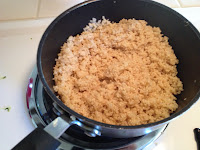
So I found a recipe on Pinterest that looked great, but it was in UK units and I wasn't fond of the spices that were called for, so I tweaked it a bit and now it's amazing!
We are working on getting fit for the wedding. Not that we should need a reason to get fit and eat healthier, but it's good motivation. I keep reminding Denver that with technology these days, we can count on our great-great-great-great grandchildren seeing our wedding photos, so we ought to look good in them!
I don't know what "type" of diet food this fits into.... I believe it's gluten-free, boarder-line Atkins friendly, might be Primal, but most importantly, these are super delish! Rembmer, the nice thing about cooking is how flexible a recipe can be, so I encourage people to swap out things and see how it works.
Ingredients:
1/2 cup raw quinoa (1 1/2 cups cooked)
1 medium zucchini (roughly the size of a women's forearm, ~4 cups)
1 medium onion
1-2 garlic cloves (or 1 tsp garlic from a jar)
Italian Seasonings (or whatever your favorites are: rosemary, cilantro, sage?)
1/4 cup shredded or flaked parmesan cheese
1 cup plain yogurt
4 Tbs. flour (I use half coconut flour & half almond flour)
oil (for cooking veggies, I use olive oil)
*The mixture needs to cook before cooking, so plan to make ahead of time.
1.) Start by making your quinoa according to the directions on the bag.
 |
| I fell in love with truRoots quinoa, from Costco |
2.) While the quinoa cooks, prep your veggies.
- Grate half of the zucchini, and strain to get rid extra moisture
- Dice up the other half of the zucchini
- Dice the entire onion
- Dice your garlic (if using fresh)
 |
| You should get a fair amount of liquid out, don't skip this step. |
3.) In a large skillet add oil and turn heat to medium.
- Add chopped garlic
- When oil is hot, add HALF of the onion. Heat until caramelized brown.
4.) Add all of the zucchini to the cooked onion mixture, stir.
- Stir occasionally, until zucchini are hot.
- I don't measure herbs- just sprinkle your herbs over the veggies like you are putting pepper on.
- Sprinkle parmesan cheese over veggies and stir.
 |
| If you have a wok I would use it for this! |
- Add the other half of your onions (still raw)
- Add yogurt
- Add flour (I like to mix this into the yogurt to make sure it isn't clumpy)
- Mix well.
6.) Once mixed, these puppies need to cool before cooking. Cover mix and stick in the fridge.
.
.
.
7.) When you are ready to cook your cakes, heat a skillet with oil to med or a little higher.
8.) I start by making the mixture into balls (somewhere between a golf and tennis ball size). Make sure to pack them tightly. After all of your mixture is balled up, start flattening them like hamburger patties, but be very sure to keep them compresses.
- Lay the patties in the hot oil. Don't move them until they are ready to flip.
- Once they are a golden brown on one side, flip and brown the other side.
... Be gentle, they aren't the most stable little cakes.
 |
| Finished product! |
9.) Eat and enjoy!!
Don't be shy about using your own tweaks! Here are some ideas I've thought about trying
- Use broccoli instead of zucchini
- Adding 2 eggs to help with stability, and raise the protein. (To do this, and ensure the eggs get cooked, mix the eggs and the cooled quinoa in a bowl. Then add this to the zucchini mix on the stovetop and heat. It will also be cooked during the frying process at the very end.)
- Change up the spices and herbs!
- Fall is coming. Use butternut squash, and thyme and sage, maybe even a dash of cinnamon.
Let me know what other variations you have tried and enjoyed :)






